|
Tex Murphy: Tesla Effect
Several weeks ago, when I was about two thirds of the way through Tesla Effect and becoming fed up with the
gameplay, I stopped playing and posted a disparaging rant here on the site blog. Several hours later after much soul
searching, I decided that the developers that managed to produce my second favourite adventure game of all time,
The Pandora Directive, deserved better than that. I owed it to them to finish the
game. So I did. I also took down the rant - something I'd never done before - metzomagic.com's first retraction, of sorts.
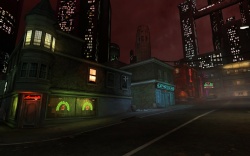 |
| Chandler Ave, your old neighbourhood |
Tesla Effect picks up where Overseer left off. Well, not exactly. It is
now the year 2050, and seven years of New San Francisco time have elapsed since Tex and Chelsee were waylaid by a taxi driver
on the way home from a dinner date in the climactic ending of Overseer. Chelsee was never found afterwards, and in the
intervening time Tex has apparently turned into a bitter and twisted simulacrum of his former self, willing to do anything for
a buck no matter the consequences. Fortunately though, the game's intro ends with Tex on the receiving end of yet another in
a historic series of nasty blows to the head, and he wakes up with a mysteriously selective amnesia, not being able to
remember a single thing that has happened during those seven years. So Tex is back to his former wise-cracking self again
much to the bewilderment, and veiled relief, of the Chandler Avenue denizens.
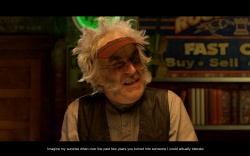 |
| Rook, as crusty as ever |
Speaking of Chandler Avenue, a good few of the same actors are back in the roles they played 18 years ago in The
Pandora Directive: Louie, Rook, Clint, Archie Ellis, and Zack are still there, looking not too much the worse for
wear. And all the old haunts are there as well, with one or two new additions. What has changed, of course, is the technology
used to produce and run video games. As is to be expected, the full motion video (FMV) sequences are now full-screen and
pretty much razor sharp in quality. But the in-game graphics don't look a whole lot different than they did in Overseer,
except a bit less pixelated. Tesla Effect does use the now ubiquitous Unity engine, whereas previous to this Access
Software's in-house Virtual World engine was employed. But a lot of the weird artefacts we saw in the later Tex Murphy games,
like 2D plants, are still there. I'm thinking that maybe there's a good reason for this. Tesla Effect was funded through a
Kickstarter campaign called Project Fedora,
and although it raised a good bit more than its $450,000 target, that probably wasn't enough to include giving the graphics a
total makeover. Also, hiring Adrian Carr again as director is going to cost a few, and you need to pay the cast and crew
something to film all that FMV. So the graphics aren't going to knock your socks off, but they are serviceable. Old vets of
the series will feel right at home.
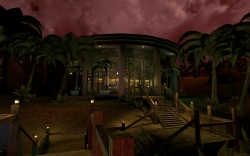 |
| A des res by the seaside |
Plot-wise, since the Aaron Conners/Chris Jones collaboration has been producing stonkingly good story lines ever since
Under a Killing Moon, it was a virtual certainty that Tesla Effect wouldn't
disappoint in this respect, and it doesn't. But it didn't all come up smelling like roses either, and I have some nits
to pick, especially regarding the gameplay.
Unlike Overseer, where it didn't seem to matter which conversation choices Tex made because it didn't affect the course of
events in the game, in Tesla Effect we're back to where it does matter. Sometimes. For like The Pandora Directive,
Tesla Effect has multiple endings that depend largely on the moral choices Tex makes at key points in the game. But the cues
given for the conversation choices are so cryptic, that even when you choose the most innocuous sounding one, Tex can wind up
producing a stream of pure invective as a result. Ouch. So I wound up with an ending that I wasn't at all happy with, and I have
literally no idea which choice(s) in which conversation(s) caused this to happen. To further complicate things, you can sometimes
be propelled through two back-to-back conversations with no chance to save your game in the interim. Ah well, I suppose this is
one way to induce us to replay the game a few times. It's not like The Pandora Directive
was
exactly a cakewalk in the dialogue choice department either :-)
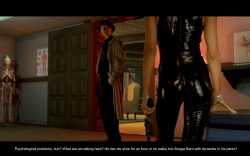 |
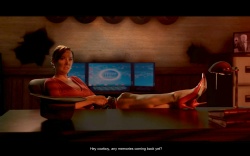 |
| Deux femmes fatales this time around |
The next aspect of gameplay that I took issue with was the necessity of hunting around in a location looking for X pieces of Y,
that were pretty well hidden, in order to progress the game. This happened, as I recall, on at least four occasions. Well, five
once you realise that the only reason for searching through a good portion of the otherwise empty rooms in this game was to
assemble a collection of comic books that, if you found all of them, unlocked some content at the end of the game. There's little
doubt where this theme came from: Big Finish Games' first few games - such as 3 Cards to Midnight - were casual, 'find the
hidden object' games, albeit with a bit more of a storyline than these usually have to offer. Anyway, I just thought that a Tex
Murphy game wasn't in any way enhanced by this addition to the gameplay. C'mon guys, we should be looking for clues to help us
save the world, instead of wasting our time with hidden objects and frivolous collectibles.
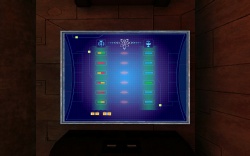 |
| This one wasn't twiddleware. Good puzzle, actually |
The puzzles have never exactly been the strong point of Tex Murphy games, but it seems to me like after a 15-year break, putting
some effort into crafting a few ripping good puzzles that blended into the environment would have been a worthy design goal.
Instead we got two sliding tile puzzles, a variation on wolf/sheep/cabbage/boat, and a bumper crop of what I like to call
'twiddleware' - puzzles that have inadequate clues provided as to how they can be methodically solved. You just have to keep
twiddling with the puzzle until you, usually randomly, stumble upon the solution. And as for the final puzzle - it's actually
difficult to put into words how I feel about twiddleware involving tiny, mouse-unfriendly dials and tight time limits. But you
can probably imagine that they are not nice words.
Oh, and I almost forgot to mention that as with all of the later Tex Murphy games, there are two modes you can play in:
Entertainment or Gamer. In Entertainment mode you can get hints for the puzzles, and also, when you sweep a flashlight over
something that you can interact with, it sparkles. In Gamer mode, which I always play in, no hints are available and neither is
the sparkle feature. Less points are available for solving the puzzles in Entertainment mode but, meh, who cares? You get points
for just clicking on portraits of random people that are hung all over the walls in this game, so keeping track of points becomes
largely irrelevant for all but the anally retentive among us. Oh wait, that's me. Never mind.
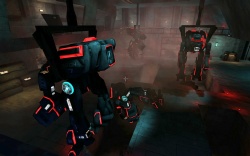 |
| Obligatory abandoned high tech facility, but it was cool |
Have my feelings about Tesla Effect changed substantially now that I decided to stick with it till the finish? Hmm.
Probably not. So yeah, this was more a labour of love to bring Tex back to our small screens than anything else, and I suspect
the fan base was, like myself, pleased enough with the result. The wry, self-deprecating Tex Murphy humour that was always there
is still there in abundance, the acting is up to its usual cheesy standard, and the story is well paced and interesting. The theme
song was a cracker as well. It's just that... well, it would have been really nice to see Tex go out on a high note.
Copyright © Steve Metzler 2015.
All rights reserved.
System Requirements:
If your Windows PC can't run this, you need a new PC. Also available for Linux and OS X.
|

